Sociological Theories of Crime: Labeling Theory and Social Learning Theory
VerifiedAdded on 2023/04/25
|7
|1517
|466
AI Summary
This article discusses the two sociological theories of crime, labeling theory and social learning theory, and compares and contrasts them. It also describes crimes according to each theory and their policy implications. Suitable programs for each theory are also suggested.
Contribute Materials
Your contribution can guide someone’s learning journey. Share your
documents today.
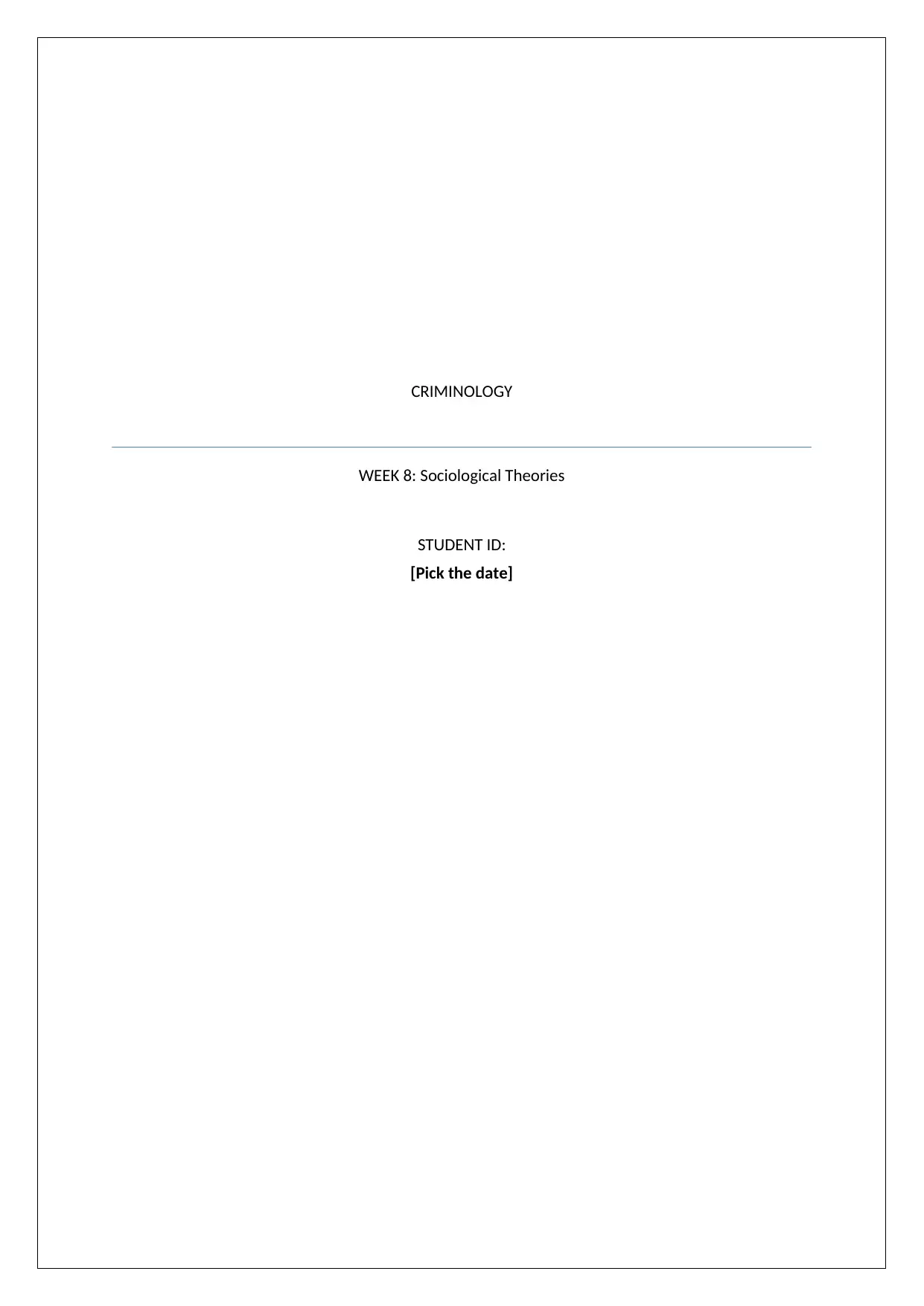
CRIMINOLOGY
WEEK 8: Sociological Theories
STUDENT ID:
[Pick the date]
WEEK 8: Sociological Theories
STUDENT ID:
[Pick the date]
Secure Best Marks with AI Grader
Need help grading? Try our AI Grader for instant feedback on your assignments.
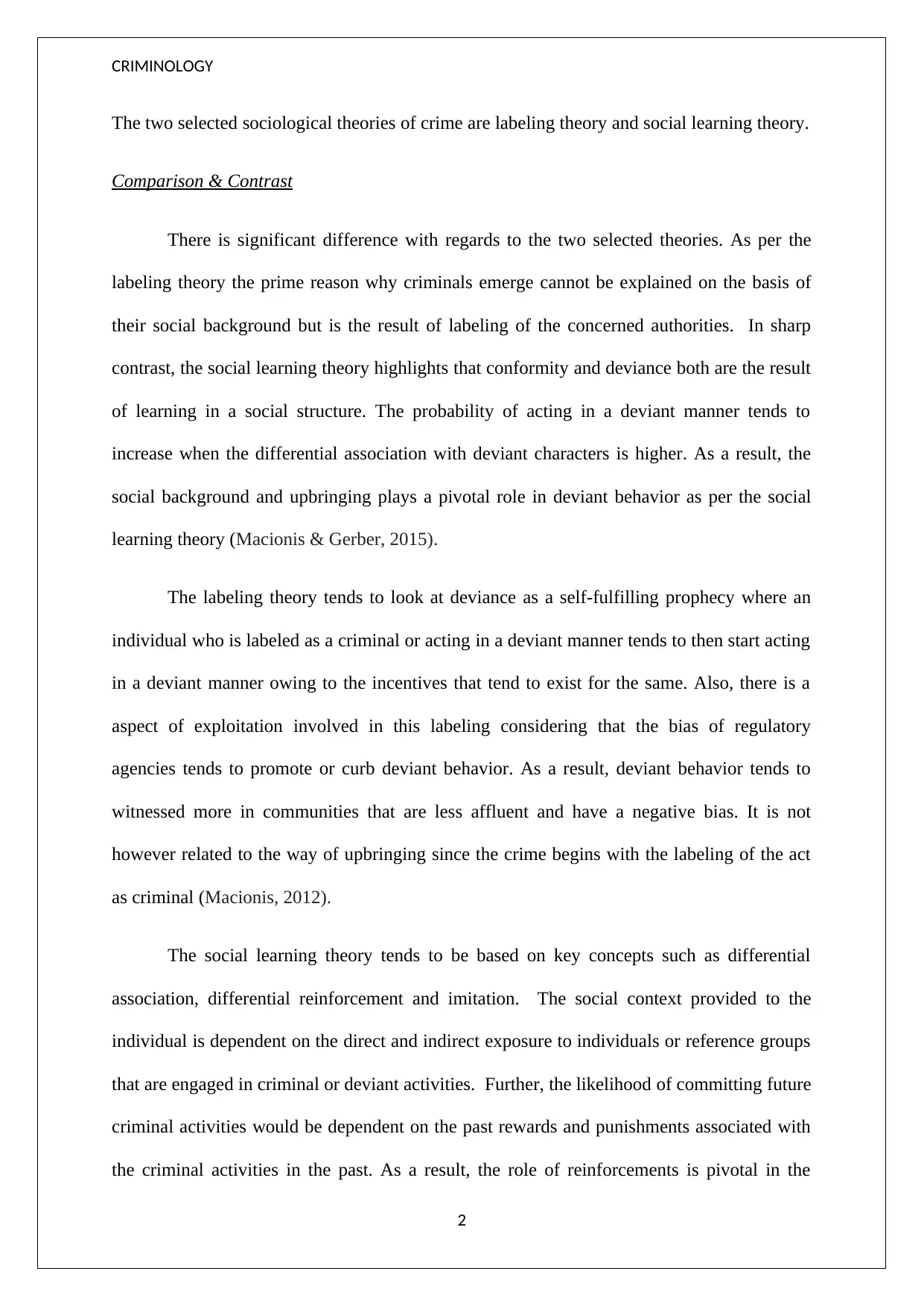
CRIMINOLOGY
The two selected sociological theories of crime are labeling theory and social learning theory.
Comparison & Contrast
There is significant difference with regards to the two selected theories. As per the
labeling theory the prime reason why criminals emerge cannot be explained on the basis of
their social background but is the result of labeling of the concerned authorities. In sharp
contrast, the social learning theory highlights that conformity and deviance both are the result
of learning in a social structure. The probability of acting in a deviant manner tends to
increase when the differential association with deviant characters is higher. As a result, the
social background and upbringing plays a pivotal role in deviant behavior as per the social
learning theory (Macionis & Gerber, 2015).
The labeling theory tends to look at deviance as a self-fulfilling prophecy where an
individual who is labeled as a criminal or acting in a deviant manner tends to then start acting
in a deviant manner owing to the incentives that tend to exist for the same. Also, there is a
aspect of exploitation involved in this labeling considering that the bias of regulatory
agencies tends to promote or curb deviant behavior. As a result, deviant behavior tends to
witnessed more in communities that are less affluent and have a negative bias. It is not
however related to the way of upbringing since the crime begins with the labeling of the act
as criminal (Macionis, 2012).
The social learning theory tends to be based on key concepts such as differential
association, differential reinforcement and imitation. The social context provided to the
individual is dependent on the direct and indirect exposure to individuals or reference groups
that are engaged in criminal or deviant activities. Further, the likelihood of committing future
criminal activities would be dependent on the past rewards and punishments associated with
the criminal activities in the past. As a result, the role of reinforcements is pivotal in the
2
The two selected sociological theories of crime are labeling theory and social learning theory.
Comparison & Contrast
There is significant difference with regards to the two selected theories. As per the
labeling theory the prime reason why criminals emerge cannot be explained on the basis of
their social background but is the result of labeling of the concerned authorities. In sharp
contrast, the social learning theory highlights that conformity and deviance both are the result
of learning in a social structure. The probability of acting in a deviant manner tends to
increase when the differential association with deviant characters is higher. As a result, the
social background and upbringing plays a pivotal role in deviant behavior as per the social
learning theory (Macionis & Gerber, 2015).
The labeling theory tends to look at deviance as a self-fulfilling prophecy where an
individual who is labeled as a criminal or acting in a deviant manner tends to then start acting
in a deviant manner owing to the incentives that tend to exist for the same. Also, there is a
aspect of exploitation involved in this labeling considering that the bias of regulatory
agencies tends to promote or curb deviant behavior. As a result, deviant behavior tends to
witnessed more in communities that are less affluent and have a negative bias. It is not
however related to the way of upbringing since the crime begins with the labeling of the act
as criminal (Macionis, 2012).
The social learning theory tends to be based on key concepts such as differential
association, differential reinforcement and imitation. The social context provided to the
individual is dependent on the direct and indirect exposure to individuals or reference groups
that are engaged in criminal or deviant activities. Further, the likelihood of committing future
criminal activities would be dependent on the past rewards and punishments associated with
the criminal activities in the past. As a result, the role of reinforcements is pivotal in the
2
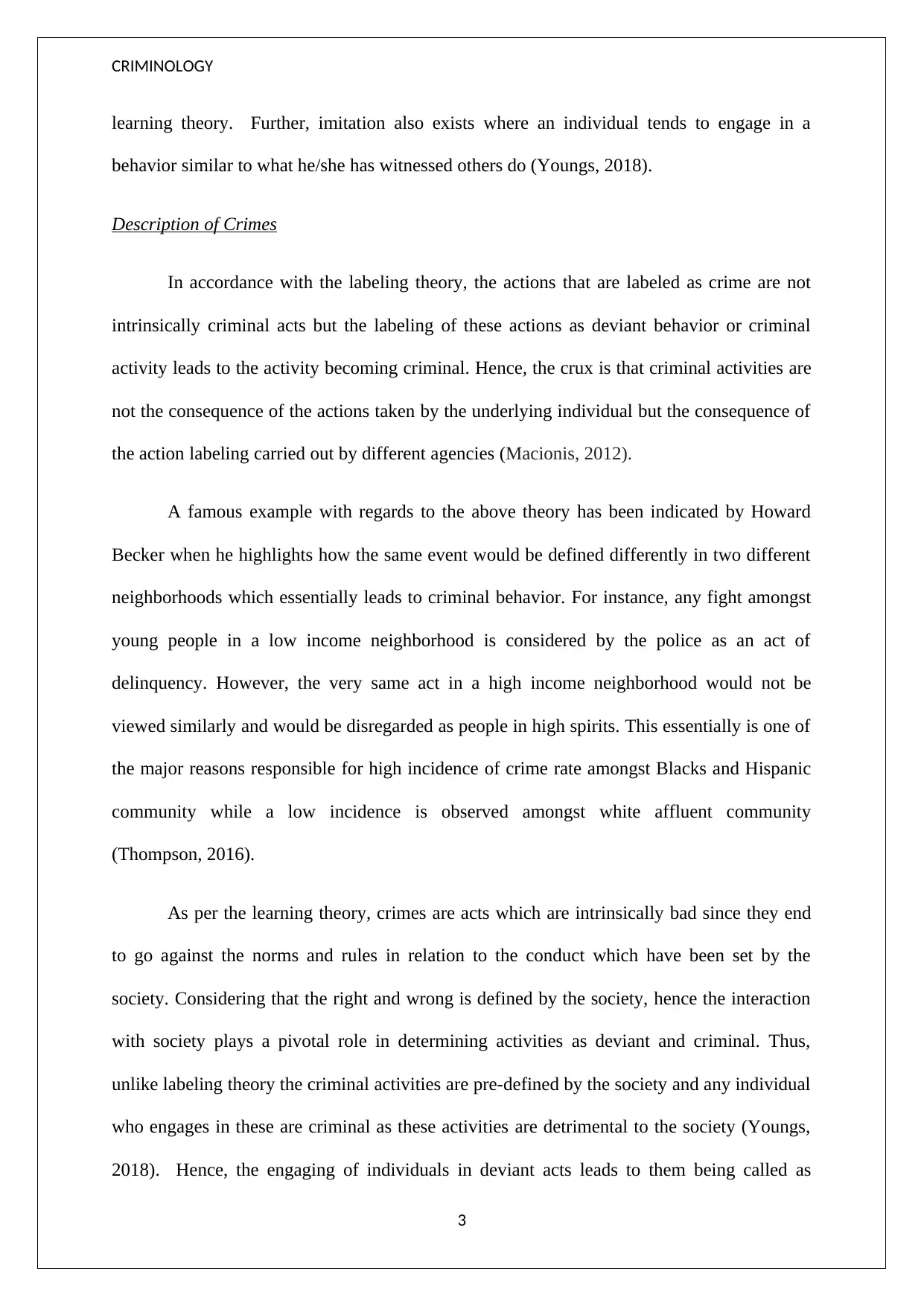
CRIMINOLOGY
learning theory. Further, imitation also exists where an individual tends to engage in a
behavior similar to what he/she has witnessed others do (Youngs, 2018).
Description of Crimes
In accordance with the labeling theory, the actions that are labeled as crime are not
intrinsically criminal acts but the labeling of these actions as deviant behavior or criminal
activity leads to the activity becoming criminal. Hence, the crux is that criminal activities are
not the consequence of the actions taken by the underlying individual but the consequence of
the action labeling carried out by different agencies (Macionis, 2012).
A famous example with regards to the above theory has been indicated by Howard
Becker when he highlights how the same event would be defined differently in two different
neighborhoods which essentially leads to criminal behavior. For instance, any fight amongst
young people in a low income neighborhood is considered by the police as an act of
delinquency. However, the very same act in a high income neighborhood would not be
viewed similarly and would be disregarded as people in high spirits. This essentially is one of
the major reasons responsible for high incidence of crime rate amongst Blacks and Hispanic
community while a low incidence is observed amongst white affluent community
(Thompson, 2016).
As per the learning theory, crimes are acts which are intrinsically bad since they end
to go against the norms and rules in relation to the conduct which have been set by the
society. Considering that the right and wrong is defined by the society, hence the interaction
with society plays a pivotal role in determining activities as deviant and criminal. Thus,
unlike labeling theory the criminal activities are pre-defined by the society and any individual
who engages in these are criminal as these activities are detrimental to the society (Youngs,
2018). Hence, the engaging of individuals in deviant acts leads to them being called as
3
learning theory. Further, imitation also exists where an individual tends to engage in a
behavior similar to what he/she has witnessed others do (Youngs, 2018).
Description of Crimes
In accordance with the labeling theory, the actions that are labeled as crime are not
intrinsically criminal acts but the labeling of these actions as deviant behavior or criminal
activity leads to the activity becoming criminal. Hence, the crux is that criminal activities are
not the consequence of the actions taken by the underlying individual but the consequence of
the action labeling carried out by different agencies (Macionis, 2012).
A famous example with regards to the above theory has been indicated by Howard
Becker when he highlights how the same event would be defined differently in two different
neighborhoods which essentially leads to criminal behavior. For instance, any fight amongst
young people in a low income neighborhood is considered by the police as an act of
delinquency. However, the very same act in a high income neighborhood would not be
viewed similarly and would be disregarded as people in high spirits. This essentially is one of
the major reasons responsible for high incidence of crime rate amongst Blacks and Hispanic
community while a low incidence is observed amongst white affluent community
(Thompson, 2016).
As per the learning theory, crimes are acts which are intrinsically bad since they end
to go against the norms and rules in relation to the conduct which have been set by the
society. Considering that the right and wrong is defined by the society, hence the interaction
with society plays a pivotal role in determining activities as deviant and criminal. Thus,
unlike labeling theory the criminal activities are pre-defined by the society and any individual
who engages in these are criminal as these activities are detrimental to the society (Youngs,
2018). Hence, the engaging of individuals in deviant acts leads to them being called as
3
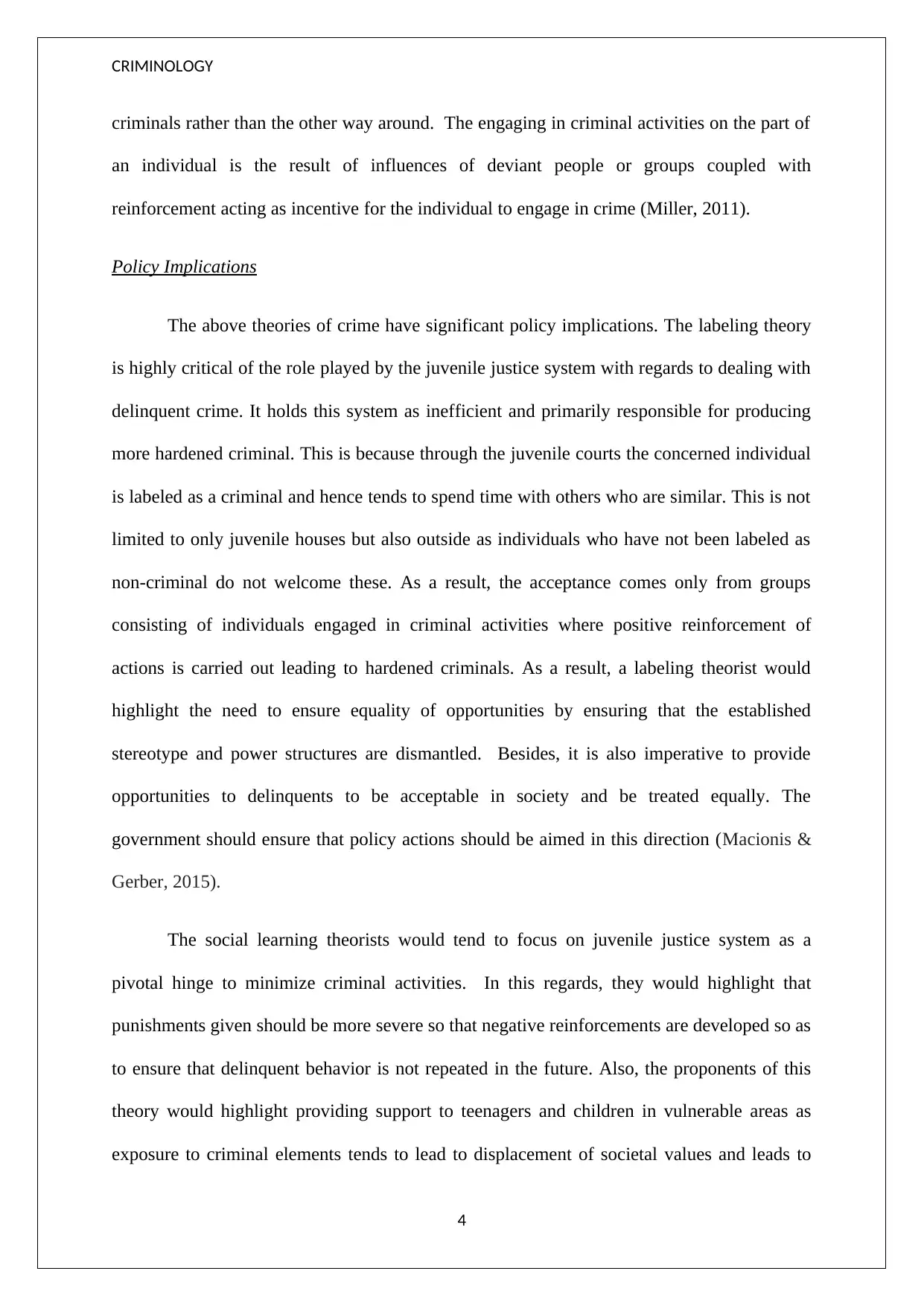
CRIMINOLOGY
criminals rather than the other way around. The engaging in criminal activities on the part of
an individual is the result of influences of deviant people or groups coupled with
reinforcement acting as incentive for the individual to engage in crime (Miller, 2011).
Policy Implications
The above theories of crime have significant policy implications. The labeling theory
is highly critical of the role played by the juvenile justice system with regards to dealing with
delinquent crime. It holds this system as inefficient and primarily responsible for producing
more hardened criminal. This is because through the juvenile courts the concerned individual
is labeled as a criminal and hence tends to spend time with others who are similar. This is not
limited to only juvenile houses but also outside as individuals who have not been labeled as
non-criminal do not welcome these. As a result, the acceptance comes only from groups
consisting of individuals engaged in criminal activities where positive reinforcement of
actions is carried out leading to hardened criminals. As a result, a labeling theorist would
highlight the need to ensure equality of opportunities by ensuring that the established
stereotype and power structures are dismantled. Besides, it is also imperative to provide
opportunities to delinquents to be acceptable in society and be treated equally. The
government should ensure that policy actions should be aimed in this direction (Macionis &
Gerber, 2015).
The social learning theorists would tend to focus on juvenile justice system as a
pivotal hinge to minimize criminal activities. In this regards, they would highlight that
punishments given should be more severe so that negative reinforcements are developed so as
to ensure that delinquent behavior is not repeated in the future. Also, the proponents of this
theory would highlight providing support to teenagers and children in vulnerable areas as
exposure to criminal elements tends to lead to displacement of societal values and leads to
4
criminals rather than the other way around. The engaging in criminal activities on the part of
an individual is the result of influences of deviant people or groups coupled with
reinforcement acting as incentive for the individual to engage in crime (Miller, 2011).
Policy Implications
The above theories of crime have significant policy implications. The labeling theory
is highly critical of the role played by the juvenile justice system with regards to dealing with
delinquent crime. It holds this system as inefficient and primarily responsible for producing
more hardened criminal. This is because through the juvenile courts the concerned individual
is labeled as a criminal and hence tends to spend time with others who are similar. This is not
limited to only juvenile houses but also outside as individuals who have not been labeled as
non-criminal do not welcome these. As a result, the acceptance comes only from groups
consisting of individuals engaged in criminal activities where positive reinforcement of
actions is carried out leading to hardened criminals. As a result, a labeling theorist would
highlight the need to ensure equality of opportunities by ensuring that the established
stereotype and power structures are dismantled. Besides, it is also imperative to provide
opportunities to delinquents to be acceptable in society and be treated equally. The
government should ensure that policy actions should be aimed in this direction (Macionis &
Gerber, 2015).
The social learning theorists would tend to focus on juvenile justice system as a
pivotal hinge to minimize criminal activities. In this regards, they would highlight that
punishments given should be more severe so that negative reinforcements are developed so as
to ensure that delinquent behavior is not repeated in the future. Also, the proponents of this
theory would highlight providing support to teenagers and children in vulnerable areas as
exposure to criminal elements tends to lead to displacement of societal values and leads to
4
Secure Best Marks with AI Grader
Need help grading? Try our AI Grader for instant feedback on your assignments.
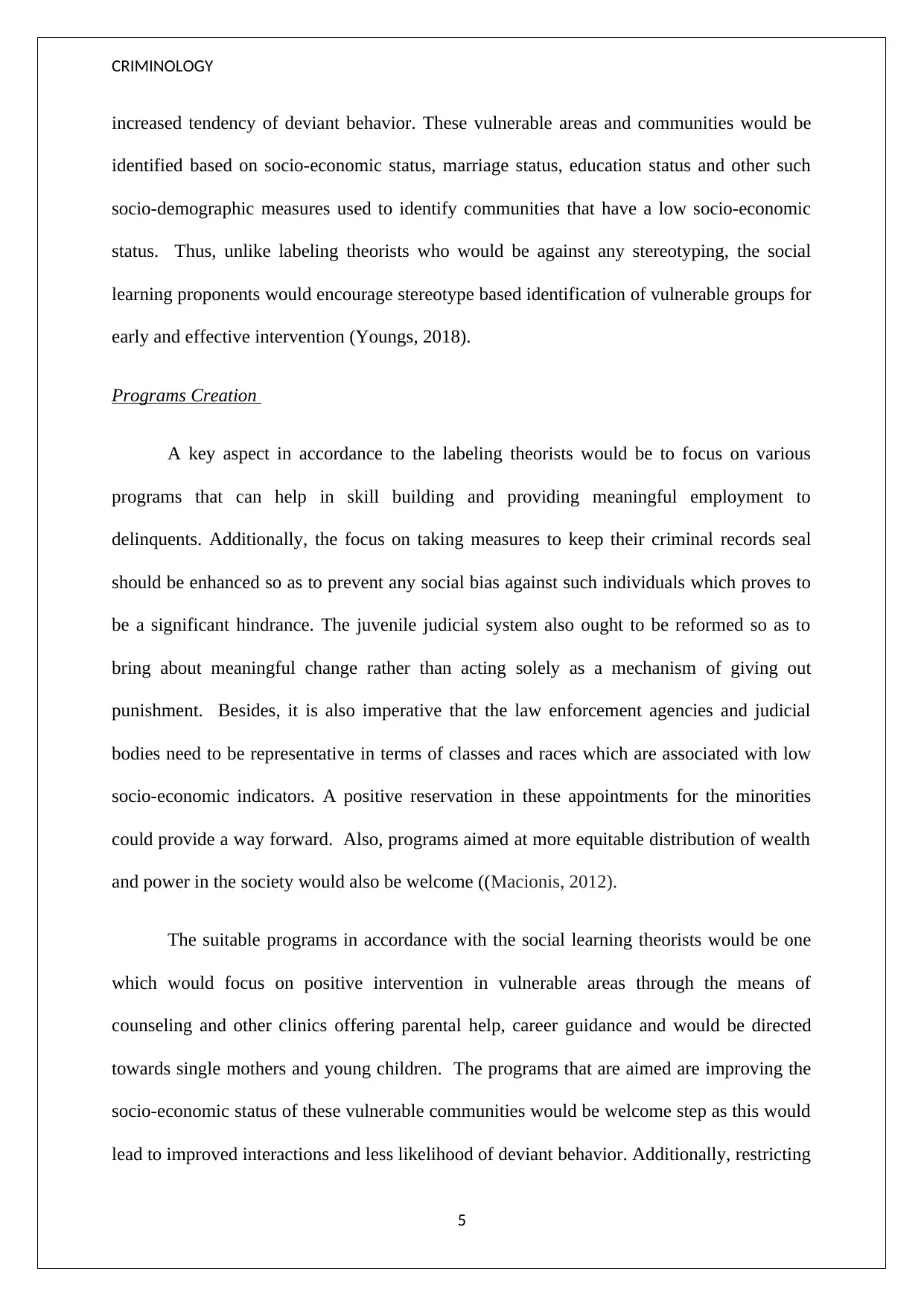
CRIMINOLOGY
increased tendency of deviant behavior. These vulnerable areas and communities would be
identified based on socio-economic status, marriage status, education status and other such
socio-demographic measures used to identify communities that have a low socio-economic
status. Thus, unlike labeling theorists who would be against any stereotyping, the social
learning proponents would encourage stereotype based identification of vulnerable groups for
early and effective intervention (Youngs, 2018).
Programs Creation
A key aspect in accordance to the labeling theorists would be to focus on various
programs that can help in skill building and providing meaningful employment to
delinquents. Additionally, the focus on taking measures to keep their criminal records seal
should be enhanced so as to prevent any social bias against such individuals which proves to
be a significant hindrance. The juvenile judicial system also ought to be reformed so as to
bring about meaningful change rather than acting solely as a mechanism of giving out
punishment. Besides, it is also imperative that the law enforcement agencies and judicial
bodies need to be representative in terms of classes and races which are associated with low
socio-economic indicators. A positive reservation in these appointments for the minorities
could provide a way forward. Also, programs aimed at more equitable distribution of wealth
and power in the society would also be welcome ((Macionis, 2012).
The suitable programs in accordance with the social learning theorists would be one
which would focus on positive intervention in vulnerable areas through the means of
counseling and other clinics offering parental help, career guidance and would be directed
towards single mothers and young children. The programs that are aimed are improving the
socio-economic status of these vulnerable communities would be welcome step as this would
lead to improved interactions and less likelihood of deviant behavior. Additionally, restricting
5
increased tendency of deviant behavior. These vulnerable areas and communities would be
identified based on socio-economic status, marriage status, education status and other such
socio-demographic measures used to identify communities that have a low socio-economic
status. Thus, unlike labeling theorists who would be against any stereotyping, the social
learning proponents would encourage stereotype based identification of vulnerable groups for
early and effective intervention (Youngs, 2018).
Programs Creation
A key aspect in accordance to the labeling theorists would be to focus on various
programs that can help in skill building and providing meaningful employment to
delinquents. Additionally, the focus on taking measures to keep their criminal records seal
should be enhanced so as to prevent any social bias against such individuals which proves to
be a significant hindrance. The juvenile judicial system also ought to be reformed so as to
bring about meaningful change rather than acting solely as a mechanism of giving out
punishment. Besides, it is also imperative that the law enforcement agencies and judicial
bodies need to be representative in terms of classes and races which are associated with low
socio-economic indicators. A positive reservation in these appointments for the minorities
could provide a way forward. Also, programs aimed at more equitable distribution of wealth
and power in the society would also be welcome ((Macionis, 2012).
The suitable programs in accordance with the social learning theorists would be one
which would focus on positive intervention in vulnerable areas through the means of
counseling and other clinics offering parental help, career guidance and would be directed
towards single mothers and young children. The programs that are aimed are improving the
socio-economic status of these vulnerable communities would be welcome step as this would
lead to improved interactions and less likelihood of deviant behavior. Additionally, restricting
5
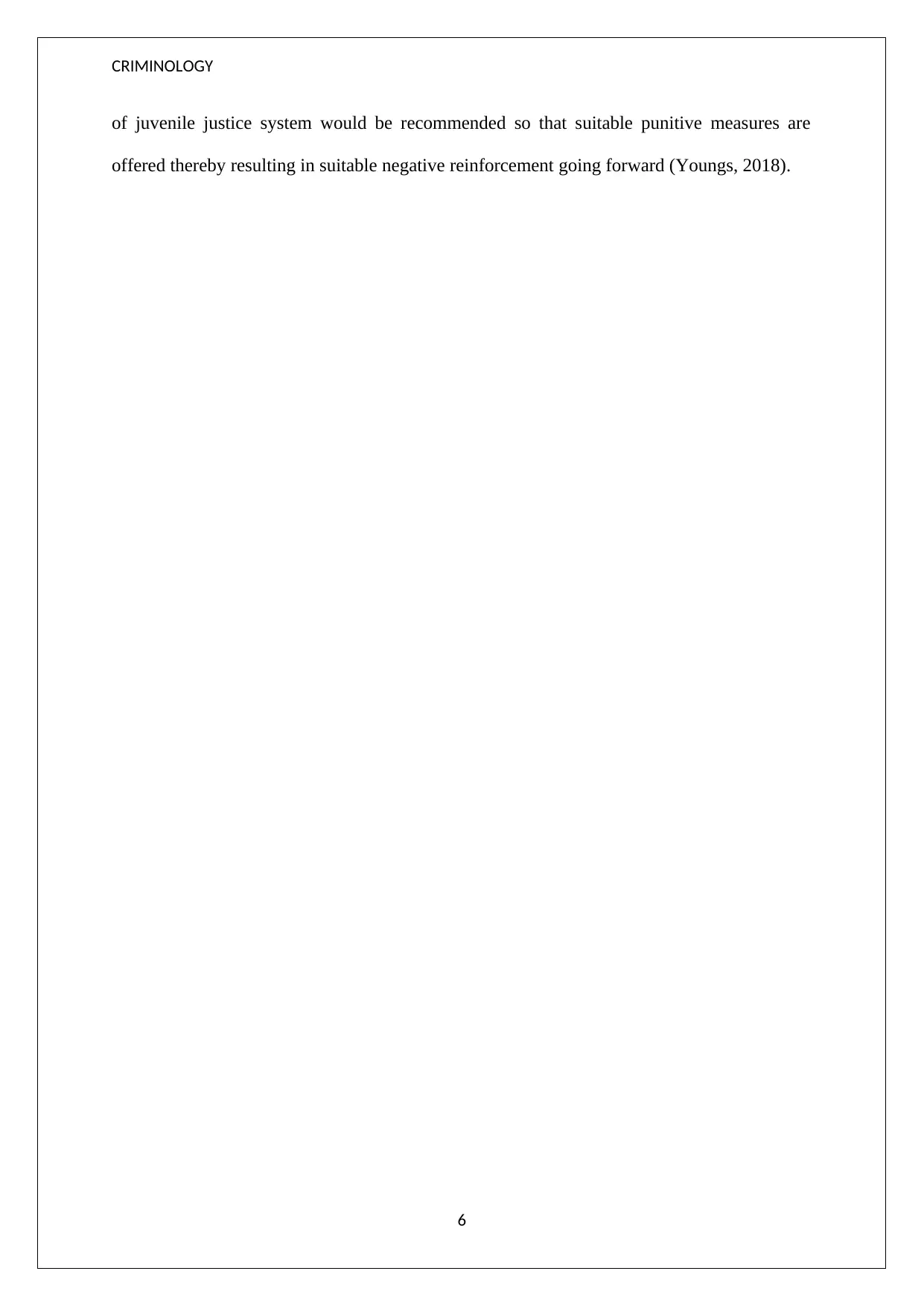
CRIMINOLOGY
of juvenile justice system would be recommended so that suitable punitive measures are
offered thereby resulting in suitable negative reinforcement going forward (Youngs, 2018).
6
of juvenile justice system would be recommended so that suitable punitive measures are
offered thereby resulting in suitable negative reinforcement going forward (Youngs, 2018).
6
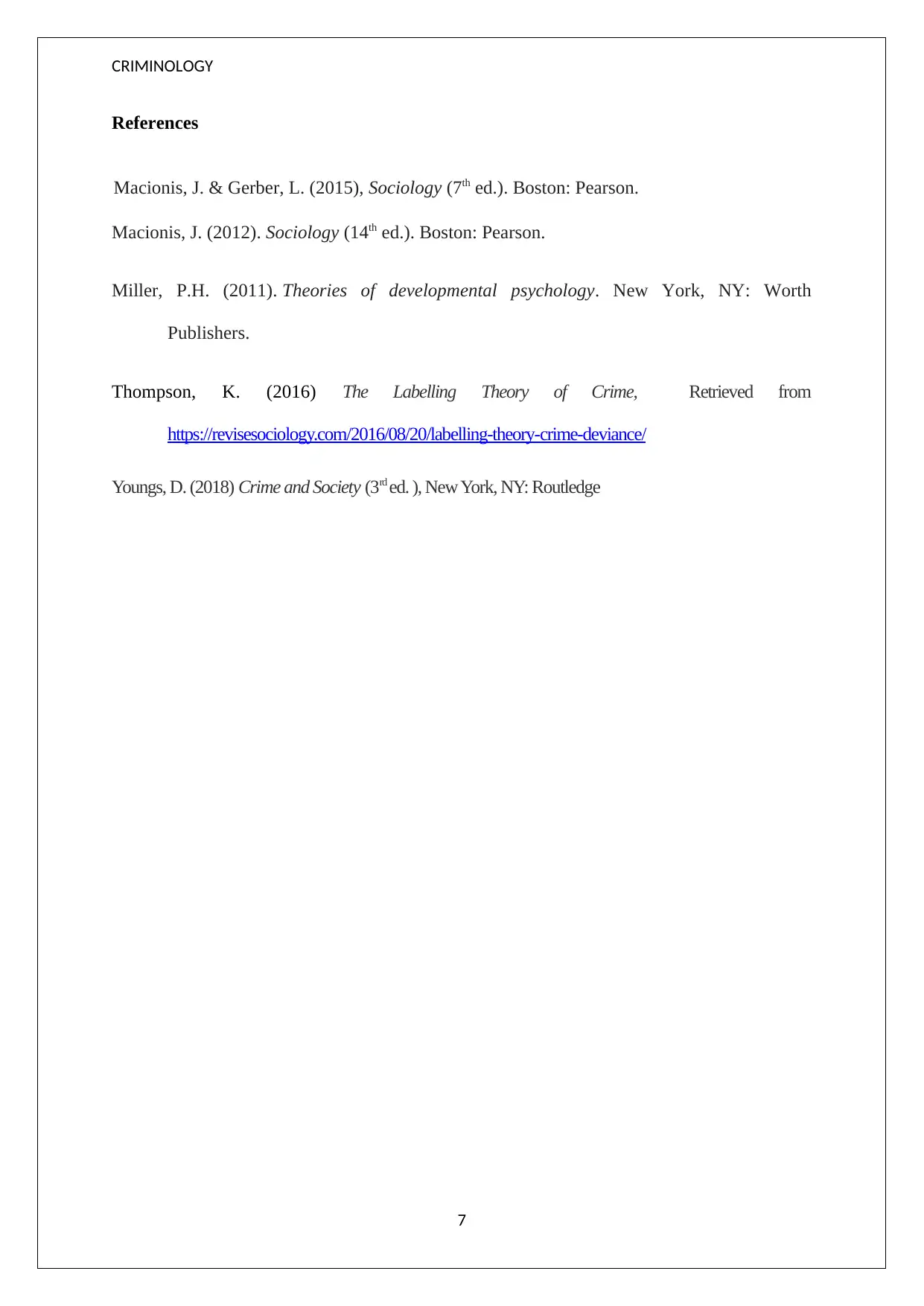
CRIMINOLOGY
References
Macionis, J. & Gerber, L. (2015), Sociology (7th ed.). Boston: Pearson.
Macionis, J. (2012). Sociology (14th ed.). Boston: Pearson.
Miller, P.H. (2011). Theories of developmental psychology. New York, NY: Worth
Publishers.
Thompson, K. (2016) The Labelling Theory of Crime, Retrieved from
https://revisesociology.com/2016/08/20/labelling-theory-crime-deviance/
Youngs, D. (2018) Crime and Society (3rd ed. ), New York, NY: Routledge
7
References
Macionis, J. & Gerber, L. (2015), Sociology (7th ed.). Boston: Pearson.
Macionis, J. (2012). Sociology (14th ed.). Boston: Pearson.
Miller, P.H. (2011). Theories of developmental psychology. New York, NY: Worth
Publishers.
Thompson, K. (2016) The Labelling Theory of Crime, Retrieved from
https://revisesociology.com/2016/08/20/labelling-theory-crime-deviance/
Youngs, D. (2018) Crime and Society (3rd ed. ), New York, NY: Routledge
7
1 out of 7
Related Documents
Your All-in-One AI-Powered Toolkit for Academic Success.
+13062052269
info@desklib.com
Available 24*7 on WhatsApp / Email
![[object Object]](/_next/static/media/star-bottom.7253800d.svg)
Unlock your academic potential
© 2024 | Zucol Services PVT LTD | All rights reserved.





